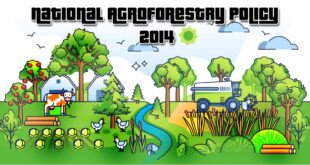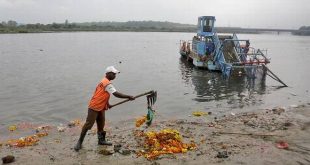Context: Recent data from an unreleased elephant census, which incorporated new counting techniques, has revealed a decline in elephant populations across several regions of India, particularly in southern West Bengal, Jharkhand, Odisha, and Kerala. Previous Counting Methods Total Direct Count Up until 2002, India used the “total direct count” method, …
Read More »Ecology
Forest Cover of India
India State of Forest Report (ISFR) The Union Minister of State for Environment, Forest, and Climate Change presented the India State of Forest Report of 2021 in Lok Sabha, amidst contradictions with Global Forest Watch data. ISFR: An assessment of forest cover and tree cover (small patches outside forests) conducted …
Read More »Climate Policy of India
Context: India’s Supreme Court, in its landmark judgment in M.K. Ranjitsinh and Ors. Vs. Union of India & Ors., has introduced a significant new dimension to the country’s climate change jurisprudence. SC Verdict The Supreme Court recognized the right to “be free from the adverse effects of climate change” as …
Read More »To preserve forests, it’s important to listen to tribal communities
GS3: Biodiversity Conservation, Engaging Tribal communities in Forest Management, The Wild Life (Protection) Act, 1972, The Forest Conservation Act, 1980, National Forest Academy, Articles 14 and 21 of the Constitution. Recently, the President of India gave a congratulatory message to the 2022 batch of Indian Forest Service (IFoS) trainee …
Read More »Rangeland Degradation: Impacts, Causes, and Responses in India
Introduction Rangelands, vast swathes of grasslands, shrublands, and savannahs, are crucial ecosystems supporting livestock grazing, biodiversity, and ecological balance. However, rangeland degradation is a growing concern globally, with significant implications for India. Rangeland Degradation: Causes Overgrazing: Excessive livestock numbers exceeding the carrying capacity of the land lead to depletion of …
Read More »Lakshadweep coral reefs undergoing severe bleaching
GS Paper III – Environment & Ecology : Biodiversity: Coral reefs are hotspots of marine biodiversity. Coral bleaching disrupts these ecosystems, leading to species decline. Climate Change: Rising sea temperatures due to climate change are the primary cause of coral bleaching. Conservation: Understanding the threats to coral reefs and discussing …
Read More »Balanced Fertilization and the Path Forward
Introduction Balanced fertilization is a crucial aspect of sustainable agriculture, aiming to provide crops with the optimal combination of primary, secondary, and micronutrients they require for healthy growth and maximum yield. Understanding Balanced Fertilization: Importance: Balanced fertilization ensures optimal nutrient uptake by crops, leading to improved yields, soil health, and …
Read More »Stubble Burning in India & its Alternatives to fight Pollution
Introduction Stubble burning, the practice of setting fire to leftover crop residue after harvest, is a major environmental concern in India. This widespread practice, particularly in northern states like Punjab, Haryana, and Uttar Pradesh, contributes significantly to air pollution, impacting public health and overall environmental quality. Negative Consequences of Stubble …
Read More »National Agroforestry Policy 2014
Introduction: The National Agroforestry Policy 2014 was introduced by the Government of India to promote sustainable agroforestry practices across the country. Key Objectives: Encourage widespread adoption of agroforestry to enhance income generation and livelihood security for farmers. Facilitate ecological sustainability by promoting the integration of trees with agriculture. Strengthen the …
Read More »Unveiling the Potential: Exploring Sustainable Shrimp Cultivation Practices in India’s Aquaculture Sector for Economic Growth and Environmental Conservation
Concept TABLE OF CONTENTS Introduction Key Features of Shrimp Cultivation: Contribution to Economy and Employment: Government Initiatives and Regulations Introduction • Shrimp cultivation, also known as shrimp farming or aquaculture, is the practice of cultivating shrimp for commercial purposes. • Cultivation of shrimps is a significant economic activity, particularly along …
Read More »Acid rain and Fossil Fuels
Our dependence on fossil fuels like coal, oil, and natural gas comes at a hidden cost. When burned for electricity generation, industrial processes, or transportation, these fuels release harmful pollutants into the atmosphere. The primary polutars behind acid rain are sulfur dioxide (SO2) and nitrogen oxides (NOx). Imagine a power …
Read More »Air Pollution
India is the world’s second most polluted country. Fine particulate air pollution (PM2.5) in comparison to WHO guidelines shortens an average Indian’s life expectancy by 5.3 years. Records show that in 2019 over 1.6 million deaths were attributed to poor air quality. This ranged from strokes, diabetes, lung cancer and …
Read More »Our focus is farm sector: Modi
With farmer issues taking centre stage in the run-up to the Lok Sabha election, Prime Minister Narendra Modi on Monday said the BJP-led government was making dedicated efforts to bring a fundamental transformation in the farm sector. The Centre was taking a new initiative with a scientific approach to bring …
Read More »Western Ghats is home to the Eurasian otter
You’d imagine that a mammal more than a metre long would be hard to miss. But it has taken more than 70 years to confirm the presence of the elusive Eurasian otter — one of the least-known of India’s three otter species — in the Western Ghats. Ironically, researchers found …
Read More »Picking out silent ghosts in the deep
Diver-activists are removing abandoned or lost fishing nets that trap sea life It’s a lazy Sunday morning, but not for Suneha Jagannathan. With over 3 kg of diving gear, she is out on a mission — to collect ‘ghost nets’. Diving to depths of 30-50 m, Ms. Jagannathan, CEO of …
Read More »Picking out silent ghosts in the deep
Temple Adventures, a recreational scuba diving operator, has been conducting ghost net removal programmes since its inception in 2008, and with support from the Wildlife Trust of India since February 2018. Dive against debris “We usually find ghost nets about 12 km off the coast of Puducherry, at depths of …
Read More »India sees highest seizure of black spotted turtles
Study analysed data from seven South Asian countries India accounts for 29% of black spotted turtles (Geoclemys hamiltonii) seized from across seven countries in South Asia, states a recent report by TRAFFIC, an international network monitoring trade in wildlife. Classified as vulnerable by the IUCN (International Union for Conservation of …
Read More »Bengal officials race against time to save rescued corals
These have to be restored to their original habitats on the T.N. coast in 48 hours Unlike the other seizures in the past, officials of the Wildlife Crime Control Bureau (WCCB) faced a different kind of challenge when they recovered 20 live corals from a house in Dum Dum in …
Read More »River pollution: NGT directs States to act
Orders preparation of action plans within two months Taking suo motu cognisance of a report in The Hindu on the increase in polluted river stretches in the country, the National Green Tribunal (NGT) has directed all States and Union Territories to prepare action plans within two months. Stating that the …
Read More » Chinmaya IAS Academy – Current Affairs Chinmaya IAS Academy – Current Affairs
Chinmaya IAS Academy – Current Affairs Chinmaya IAS Academy – Current Affairs


















